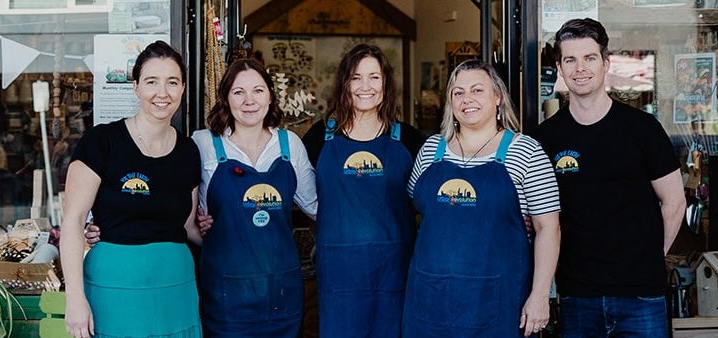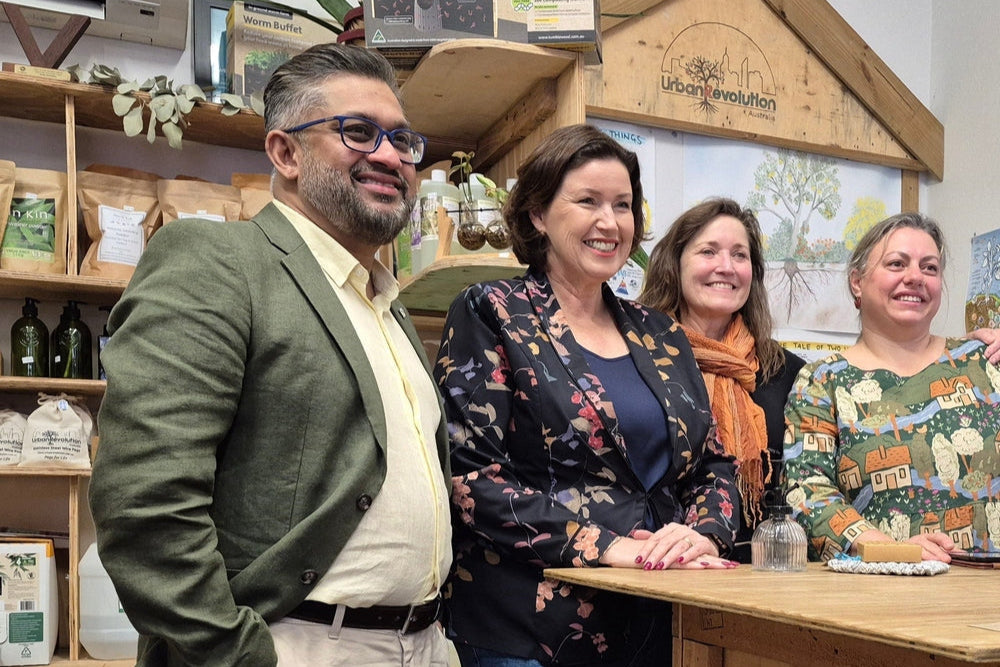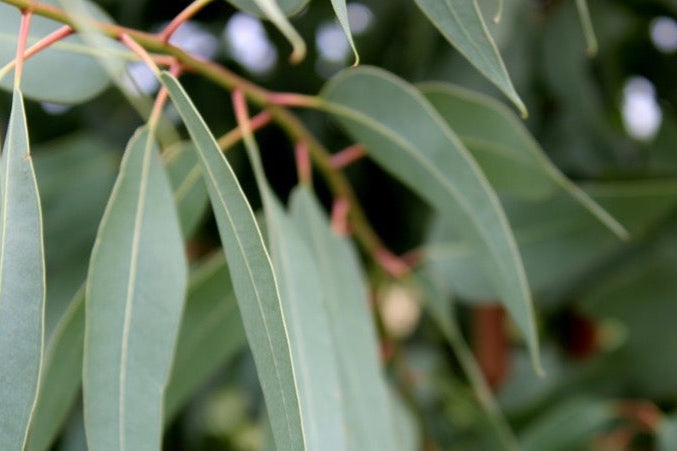Composting is an easy and impactful way to reduce household waste. If you have a garden, it’s also an awesome way to feed your plants for free. But you don’t need a big space to compost. Even if you have a small yard or live in an apartment, you can compost in a way that works for your situation.
Here’s our beginner's guide to urban composting. If you're keen to gain more confidence and in-depth knowledge, check out our Urban Composting workshops in Perth and our Urban Revolution Composting Guidebook.
What is compost?
Compost looks like soil, but is actually broken down organic matter. It’s the result of decomposing things like food scraps, leaves and plant material, coffee grounds, cardboard, manure and other organic materials.
A forest has its own way of feeding itself. Fallen leaves and branches, as well as animal manure, are broken down by worms, fungi and other decomposers living in the soil. They create a dark brown, rich matter called humus which creates a healthy, nutritious environment for the growth of plants.
When you compost, you’re essentially doing the same kind of thing, although in a more controlled and managed way.
Why compost?
Composting is one of the best ways to reduce household waste. Instead of food scraps, paper, cardboard and pet waste ending up in landfill, composting turns the materials into something useful.
Did you know that organic materials don’t break down properly when they end up in landfill? And because of this, they can end up creating methane and carbon dioxide, contributing to environmental problems. Composting is the best way to process organic materials, actually converting them into something useful and not harmful to the planet.
Read more abouthow compost helps reverse climate change.
A free way to feed your garden
If you have a garden or even a few pot plants, adding compost to your soil is a great way to feed your plants and give them the nutrients they need to grow. It’ll also help make your living soil ecosystem healthier, improve the texture of your soil and help your garden maintain more moisture. If you make your own compost, you can do all this for free!
Even if you don’t have your own garden or pot plants, you can give your compost to someone who does. Gardeners often call compost “black gold” because it’s so good for the garden, and you’re likely to find many people in your community who are keen to have more of it.
What can be composted?
In theory, anything made from organic materials can be composted. That includes fruit and veg, coffee grounds, plant material, clothes made from natural fIbres, paper and cardboard.
In practice, it depends on what system you’re using.Worms in a worm farm for example, can’t digest things like onion peels and citrus very well. However, these are fine to toss in your large compost bin.
In a home compost system, you generally want to avoid meat and dairy as they have a hard time breaking down and can attract rodents. However, these are fine to add to your Bokashi bin!
See the ‘Types of Composting’ section below for more specifics about what can and can’t go in the different systems.
Aim for a mix of ‘browns’ and ‘greens’
Most compost systems require a balanced input of carbon and nitrogen.
-
Carbon rich materials, sometimes called ‘browns’, are things like paper, cardboard, dead leaves and natural fibres.
-
Nitrogen rich materials, sometimes called ‘greens’, are things like fruit and veg scraps, green plant material and grass clippings. Coffee grounds are also nitrogen-rich ‘greens’!
A good rule of thumb for home composting is to put two parts ‘browns’ for every one part of ‘greens’ that you add. So if you put a bucket of veggie scraps in your compost bin, put two buckets of shredded paper, cardboard or dry leaves in.
Types of composting
There are many ways to compost, depending on what size space you have and how much time and effort you’re willing to put into the process.
Here’s an introduction to five different beginner-friendly ways to compost, plus a bonus 'hot composting' method for those looking to dive a little deeper:

-
Compost bin
For a super easy, no-fuss compost, simply add materials to yourcompost bin bit by bit as you go. Just remember to keep your browns and greens balanced – if you add a bucket of kitchen scraps, add two buckets of brown materials like shredded paper, cardboard or dead leaves.
Keep filling your bin until you get to the top and then let it sit for several months to break down. While you’re waiting for this bin to break down, you can start another one.
If you want to hurry the process along a little, use acompost aerator regularly. Or get a sweat on and use a pitch fork to aerate and mix up your compost.

-
In-ground compost
This method of composting involves burying a compost bin so that the lid is level with the ground. The sides of an in-ground compost have several holes in them where worms and other decomposers can move freely in and out.
Fill up your in-ground compost bin bit by bit, balancing your browns and greens as you go. Or fill it up in one go. When it’s full, let it sit and compost in place.
In-ground compost systems tend to be small and inconspicuous. Bury a few around your garden, especially near plants you want to give an extra boost of nutrients. They’ll love growing near the in-ground compost.

-
Pet waste composter
It’s safe and easy to turn your pet’s poo into compost. A popular way of doing so is using a pet waste composter like theEnsoPet system.
Like the in-ground composter, you bury the EnsoPet bin so that the lid is level with the surface of the ground. It’s neat and super discrete. Simply add your pet waste as you pick it up, and sprinkle on a bit ofEnsopet starter mix each time.
TheEnsoPet starter mix is made from wheat bran, sawdust and minerals, and inoculated with microbes. This helps break down the waste faster, stops the system from getting smelly and protects you from pathogens.

-
Worm farm
Vermicomposting is a way of making compost with the help of worms. As the worms decompose the organic matter you add, they produce a dark substance called ‘worm castings’.
Worm castings are super powerful and full of nutrients, and can be used in a range of ways to feed the garden. Simply sprinkle on the top of soil, add to water and make a compost tea or mix in with potting mix.
Worms are particularly partial to raw fruit and vegetable scraps. Keep in mind, they'll eat softer foods more quickly than harder foods because they don't have teeth. Some people like to blend their food scraps to a pulp before feeding their worms for this reason.
Avoid adding onion, citrus, meats, oils, dairy products and cooked foods to your worm farm.
Read our guide onhow to start a worm farm and check out our tips forkeeping a worm farm healthy during summer.

-
Bokashi
Bokashi is a counter-top system that works using fermentation to break down kitchen scraps. Simply add your scraps as you go, sprinkling over someBokashi mix afterwards. The Bokashi mix helps with the fermentation process and prevents the system from smelling.
What makes the Bokashi system great is that you can put meat, dairy, carbohydrates and even small bones in, as well as your vegetable and fruit leftovers.
Once your Bokashi bin is full, leave untouched for a couple of weeks until the fermentation process is complete. The system works best if you have two bins. While your first Bokashi bin is resting, fill up your second and vice versa.
You’ll be left with a small amount of fermented material, plus some ‘juice’. The fermented material can be added to your compost bin, buried in the ground or given away to someone looking to feed their garden. The Bokashi juice can be diluted and used as a fertiliser on plants. It also makes for a potent drain cleaner!
Check out this guide to starting a Bokashi kitchen compost system and save ourBokashi trouble shooting tips to your bookmarks bar to refer back to.
-
Hot composting
If you want to take your composting to the next level, try hot composting. As opposed to the slow, no-fuss ‘cold compost’ methods described above, hot composting involves maintaining your compost pile at a higher temperature. This speeds up the composting process while also killing pathogens and weed seeds.
In order to make a hot compost, you need to make a large pile. The size is important in keeping heat in the system. You also need to aerate or turn the compost regularly.
Composting workshops in Perth
Keen to dive further into composting? We invite you to join us at one of ourUrban Composting workshops in Perth where we cover all of the different composting methods, give you tips for success and answer any questions you might have.
You’ll leave with the confidence to set up a thriving compost system, prevent food waste and feed your soil for free.
Not in Perth? Check out theUrban Revolution Composting Guidebook!






Leave a comment (all fields required)